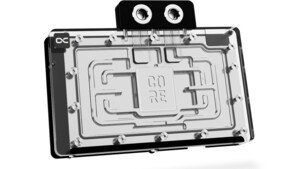Using the Unlimited Performance mode (annotated UP) with the ODROID-H4, H4+ and H4 Ultra enables the CPU to turbo boost indefinitely: 2.9 GHz all cores and 3.6 GHz one core for the H4 and H4+ , 3.0 GHz all cores and 3.8 GHz one core for the H4 Ultra.
As you may expect the CPU will get hot quickly (in a matter of minutes) and get close to his T Junction (Tj) temperature which will trigger its emergency shutdown as thermal protection. But the CPU will not reach Tj because it will automatically throttle down when it is about 5 degrees Celsius away from Tj (we tested this multiple times). As soon as the CPU thermally throttles down you start losing the increased performance you were aiming at while still consuming more power compared to the Balanced mode. Not ideal.
In order to prevent thermal throttling when using the Unlimited Performance mode, the solution is simple:
active cooling with a fan.
We designed the H4, H4+ and H4 Ultra heat sink to make it very efficient:
(a) you do not need a fan in Balanced mode
(b) it has a high rate of thermal exchange when coupled with a fan.
Using a fan will decrease the maximal CPU temperature by about 25 to 30 degrees Celsius depending on factors such as the ambient temperature. It it difficult for us to give you precise temperature values because what one witnesses depends on many factors: as already mentioned the ambient temperature, the CPU BGA soldering thickness error, the heat sink assembly tolerance, the type of thermal paste and quantity applied, the cooling fan speed RPM error margin (which can be as high as 5 to 10%). All of these factors can result in a 10+ degrees Celsius difference between one setting and another.
The important point is that with active cooling you get the increased performance you aim at while the CPU stays just comfortably warm while turbo boosting indefinitely, way below temperatures close to Tj. In other words the fan active cooling brings you the best of both worlds. This is what we witnessed and validated while performing many tests in different locations.
Last point: in Unlimited Performance mode, the CPU (and the fan) use more power than they do in Balanced mode, easily reaching 23+ W with the ODROID-H4+ and 34+ W with the ODROID-H4 Ultra. However this happens only when the CPU is indeed turbo boosting. When idle, the system will use the same power as in Balanced mode. If your goal is to minimize energy consumption, use Balanced mode. If your goal is to maximize performance use Unlimited Performance mode and again use active cooling with a fan to avoid the CPU to be constantly throttling down.
For learning how to change PL4 in the BIOS, as well as change the fan settings, please refer to the related Wiki page.
The official 92x15mm and 92x25mm 12V PWM cooling fans or similar 3rd party cooling fan should be mounted under the official cases venting holes. We have tested the following 3rd party cooling fan samples.
– Noctua NF-A19x14 PWM ( Thickness 14mm)
– Thermalright TL-9015 ( Thickness 15mm)
Unlike the previous H2 and H3 cases, the new H4 cases have been designed to allow the installation of the thin 92x15mm cooling fan inside the case. The H4 case types 1, 2 and 3 require the use of a 92x max 15mm thin fan if you want to place the fan inside the case. As the distance between the cooling fan and the heat sink is closer, we can expect a cooling effect that is not significantly different when using a thin fan.
On the other hand, the H4 case type 4 accepts both 92×15 and 25mm fans. The 92x25mm fan is recommended for the H4 case type 4. It provides higher flow and pressure than the 92x15mm fan. This allows for the air to circulate better inside the case, cooling both the CPU heat sink and the disk(s).
The ODROID-H4, H4+ and H4 Ultra use a PC standard 12V PWM 4-pin connector (see diagram shown below). Therefore, anyone can install a third-party cooling fan that can be easily purchased in the market.
https://cdn.hardkernel.com/wp-content/uploads/2024/02/12_Fan-Connector.png


